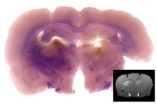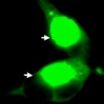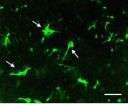(Press-News.org) CAMBRIDGE, MA -- Doctors commonly use magnetic resonance imaging (MRI) to diagnose tumors, damage from stroke, and many other medical conditions. Neuroscientists also rely on it as a research tool for identifying parts of the brain that carry out different cognitive functions.
Now, a team of biological engineers at MIT is trying to adapt MRI to a much smaller scale, allowing researchers to visualize gene activity inside the brains of living animals. Tracking these genes with MRI would enable scientists to learn more about how the genes control processes such as forming memories and learning new skills, says Alan Jasanoff, an MIT associate professor of biological engineering and leader of the research team.
"The dream of molecular imaging is to provide information about the biology of intact organisms, at the molecule level," says Jasanoff, who is also an associate member of MIT's McGovern Institute for Brain Research. "The goal is to not have to chop up the brain, but instead to actually see things that are happening inside."
To help reach that goal, Jasanoff and colleagues have developed a new way to image a "reporter gene" — an artificial gene that turns on or off to signal events in the body, much like an indicator light on a car's dashboard. In the new study, the reporter gene encodes an enzyme that interacts with a magnetic contrast agent injected into the brain, making the agent visible with MRI. This approach, described in a recent issue of the journal Chemical Biology, allows researchers to determine when and where that reporter gene is turned on.
An on/off switch
MRI uses magnetic fields and radio waves that interact with protons in the body to produce detailed images of the body's interior. In brain studies, neuroscientists commonly use functional MRI to measure blood flow, which reveals which parts of the brain are active during a particular task. When scanning other organs, doctors sometimes use magnetic "contrast agents" to boost the visibility of certain tissues.
The new MIT approach includes a contrast agent called a manganese porphyrin and the new reporter gene, which codes for a genetically engineered enzyme that alters the electric charge on the contrast agent. Jasanoff and colleagues designed the contrast agent so that it is soluble in water and readily eliminated from the body, making it difficult to detect by MRI. However, when the engineered enzyme, known as SEAP, slices phosphate molecules from the manganese porphyrin, the contrast agent becomes insoluble and starts to accumulate in brain tissues, allowing it to be seen.
The natural version of SEAP is found in the placenta, but not in other tissues. By injecting a virus carrying the SEAP gene into the brain cells of mice, the researchers were able to incorporate the gene into the cells' own genome. Brain cells then started producing the SEAP protein, which is secreted from the cells and can be anchored to their outer surfaces. That's important, Jasanoff says, because it means that the contrast agent doesn't have to penetrate the cells to interact with the enzyme.
Researchers can then find out where SEAP is active by injecting the MRI contrast agent, which spreads throughout the brain but accumulates only near cells producing the SEAP protein.
Exploring brain function
In this study, which was designed to test this general approach, the detection system revealed only whether the SEAP gene had been successfully incorporated into brain cells. However, in future studies, the researchers intend to engineer the SEAP gene so it is only active when a particular gene of interest is turned on.
Jasanoff first plans to link the SEAP gene with so-called "early immediate genes," which are necessary for brain plasticity — the weakening and strengthening of connections between neurons, which is essential to learning and memory.
"As people who are interested in brain function, the top questions we want to address are about how brain function changes patterns of gene expression in the brain," Jasanoff says. "We also imagine a future where we might turn the reporter enzyme on and off when it binds to neurotransmitters, so we can detect changes in neurotransmitter levels as well."
INFORMATION:
The research was funded by the Raymond and Beverly Sackler Foundation, the National Institutes of Health, and an MIT-Germany Seed Fund grant. The paper's lead author is former MIT postdoc Gil Westmeyer; other authors are former MIT technical assistant Yelena Emer and Jutta Lintelmann of the German Research Center for Environmental Health.
Written by Anne Trafton, MIT News Office
MRI reveals genetic activity
2014-03-25
ELSE PRESS RELEASES FROM THIS DATE:
Coerced sex not uncommon for young men, teenage boys, study finds
2014-03-25
WASHINGTON - A large proportion of teenage boys and college men report having been coerced into sex or sexual behavior, according to research published by the American Psychological Association.
A total of 43 percent of high school boys and young college men reported they had an unwanted sexual experience and of those, 95 percent said a female acquaintance was the aggressor, according to a study published online in the APA journal Psychology of Men and Masculinity.
"Sexual victimization continues to be a pervasive problem in the United States, but the victimization ...
Long-term productivity higher in university spin-offs than in other companies
2014-03-25
The study, published in the journal Technovation and written by Pere Ortín Ángel and Ferran Vendrell Herrero, covers financial data from two comparison samples of companies founded between 1994 and 2005. One sample is made up of 104 university spin-offs and the other is made up of 73 technology-based, non-university companies. The study compares what is known as the total factor productivity of these two samples. According to the study, in the university spin-offs this productivity is, on average, lower in the year in which the company is founded. Nevertheless, data shows ...
Autophagy in the initial stage is unrelated to the composition of beclin 1 complex
2014-03-25
Alteration of the autophagic process is involved in neurodegeneration. The beclin 1 complex is shown to play a key role in the initial stage of autophagy. Dr. Yanming Wei and co-coworkers from College of Life Science, Northwest Agriculture & Forestry University in China pointed out the amyotrophic lateral sclerosis-linked Cu/Zn superoxide dismutase 1 G93A mutant can upregulate autophagic activity in NSC34 cells, but that this does not markedly affect beclin 1 complex components. The relevant paper has been published in the Neural Regeneration Research (Vol. 9, No. 1, 2014).
INFORMATION:
Article: ...
Lipid rafts participate in the renewal of brain neurons in Alzheimer's disease
2014-03-25
Research over decades has implicated aberrant autophagy and lysosomal function as reliable markers and therapeutic targets for neurodegenerative diseases. Lipid rafts are shown to participate in lysosomal reproduction, and some lysosomal storage diseases are proposed to result from the accumulation of lipids in late endosomal/lysosomal compartments. Prof. Lin Yuan and team from Southern Medical University in China review the influence of lipid rafts on the progression of Alzheimer's disease through the modulation of aberrant autophagic-lysosomal pathway of amyloid-ß peptide, ...
Dab2: How to attenuate brain injury due to Alzheimer's disease?
2014-03-25
Transforming growth factor-beta (TGF-β) type II receptor (TβRII) levels are extremely low in the brain tissue of patients with Alzheimer's disease. This receptor inhibits TGF-β1/SMAD signaling and thereby aggravates amyolid-beta deposition and neuronal injury. Dab2, a specifc adapter protein, protects TβRII from degradation and ensures the effective conduction of TGF-β1/SMAD signaling. Prof. Jun Liu and team from Norman Bethune First Hospital of Jilin University in China used an adenoviral vector to overexpress Dab2 in the APP/PS1 transgenic mouse ...
The causes and consequences of global climate warming that took place 56 million years ago studied
2014-03-25
The growing and justified concern about the current global warming process has kindled the interest of the scientific community in geological records as an archive of crucial information to understand the physical and ecological effects of ancient climate changes. A study by the UPV/EHU's Palaeogene Study Group deals with the behaviour of the sea level during the Palaeocene–Eocene Thermal Maximum (PETM) 56 million years ago and has ruled out any connection. The study has been published in the journal Palaeogeography, Palaeoclimatology, Palaeoecology.
"The fall in sea ...
A non-invasive, rapid screening method for Alzheimer's disease
2014-03-25
The apolipoprotein E gene ε4 allele is considered a negative factor for neural regeneration in late-onset Alzheimer's disease cases. Apolipoprotein E genotyping is crucial to apolipoprotein E polymorphism analysis. Peripheral venous blood is the conventional tissue source for apolipoprotein E genotyping polymorphism analysis. Blood yields high-quality genomic DNA and can meet various research purposes. However, because of invasiveness, taking blood samples decreases compliance among the elderly, especially neuropsychiatric patients. Moreover, blood specimens often ...
Small peptides as potential antibiotics
2014-03-25
Drug approval requires a deep understanding of the mechanism of action
The team of Julia Bandow, who heads the RUB's Junior Research Group Microbial Antibiotic Research, has been studying the MP196 peptide as a representative of a group of very small positively charged peptides that consist of some four to ten amino acids. Earlier studies had shown that MP196 is efficient against various bacteria, including particularly problematic multi-resistant pathogens that frequently cause sepsis. How MP196 kills bacteria remained unclear. However, in order for a new substance to ...
VTT: Building to take note of individual human thermal comfort
2014-03-25
Because people in developed countries spend about 90% of their time indoors, their sense of warmth becomes one key comfort factor for interior spaces. VTT Technical Research Centre of Finland has developed a new method for assessing the individual thermal comfort experienced by different user groups. The design of energy efficient buildings – such as day care centres, schools, offices and homes for the elderly – should pay more attention in future to the thermal comfort of user groups according to real needs.
The new method developed for assessing thermal comfort (Human ...
Simple, like a neutron star
2014-03-25
In how many ways can one describe an object? Take an apple: by just looking at it we can easily estimate its weight, shape and colour but we are unable to describe it at any other level, for example, to evaluate the chemical composition of its flesh. Something similar also applies to astronomical objects: until today one of the challenges facing scientists was to describe neutron stars at the nuclear physics level. The matter these stars are made up of is in fact extremely complex, and several complicated equations of state have been proposed. However, to date there is ...




